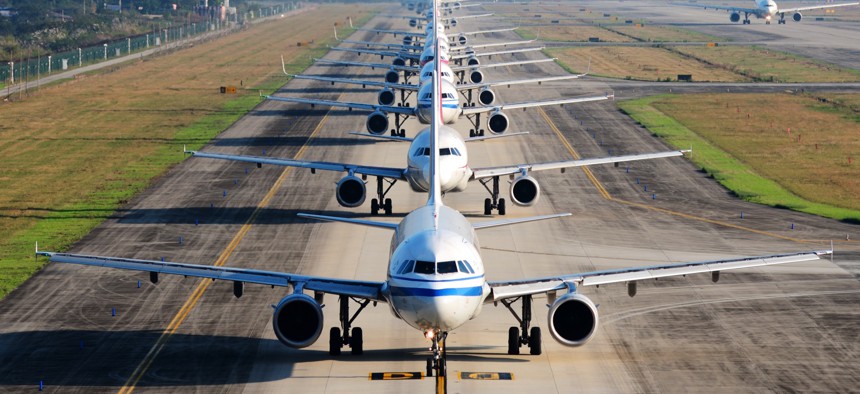
The National Airspace System Safety Review Team's report found understaffing, inconsistent funding and recruitment bottlenecks have impacted the FAA's ability to manage air travel. Jingying Zhao / GETTY IMAGES
Overtime, staffing shortages and shutdowns to blame for recent air safety issues, panel finds
A task force is calling on FAA to "urgently" address its staffing issues to avoid further risks to the flying public.
Understaffing and an overreliance on overtime by the Federal Aviation Administration are creating a less safe national airspace, according to an outside panel created to review a series of recent runway and other incidents.
The lack of an adequate workforce, a problem 40 years in the making, has trickle-down effects that create several threats to the flying public, the National Airspace System (NAS) Safety Review Team found in a report it released Wednesday. The capacity deficiencies have created inefficient operations, the team found, requiring a constant reshuffling of resources to ensure the airspace can function. In the process, it said, employees are being stretched thin and “critical redundancy” is being eliminated. FAA formed the panel in April after 10 safety incidents occurred in late 2022 and early 2023.
Overtime use is at an all-time high within FAA, which the review team said is leading to more absenteeism, lower productivity and increased fatigue. Insufficient staffing is forcing FAA to negotiate schedule reductions with certain areas to maintain the safety of operations, implement more ground stops and combine locations to fall under one post. The latter strategy creates fewer eyes on the airspace and quick decisions that could force more errors. FAA supervisors are currently serving as replacement controllers, hindering their ability to conduct their normal coordination responsibilities.
“When air traffic is rerouted, put into holding or space is increased between aircraft to accommodate understaffed adjacent areas, the opportunity for mistakes in instruction is multiplied due to the abrupt change in the operation and the increased communications required to facilitate the irregular operation,” the panel said. “While each element of risk may not be material, the combined effect of irregular operations necessitated by staff shortages erodes the margin of safety in the NAS.”
The panel made a series of recommendations it called on FAA to quickly address, related to staffing, process integrity, facilities, equipment and technology. Taken together, in combination with longstanding funding shortfalls and congressional gridlock, the issues create “an erosion of safety margins that must be urgently addressed.” They added the agency cannot provide the level of service the flying public expects without adequate resources.
“If unaddressed, the [Air Traffic Organization] will be unable to maintain current capacity, let alone expand and modernize the system,” the panel said. “The understaffing that currently exists within the ATO places additional strain on the system, further eroding the margin of safety and increasing risk.”
The staffing issue at FAA dates back to 1981 when air traffic controllers went on strike and President Reagan fired them en masse. Subsequent hiring created a retirement wave around 2005 that the agency has long struggled to address. FAA has 1,000 fewer air traffic controllers in 2023 than it did in 2012, despite a marked increase in the complexity of its operations, and the agency has put forward only a “limited effort” to address the problem. The situation has been exacerbated by the shutdown and sequestration in 2013, the 2018-2019 shutdown and the COVID-19 pandemic. Over the last decade, FAA has overseen no hiring for one year and no training for two years. It also experienced higher-than-expected attrition in 2021 and 2022.
The Senate recently confirmed Michael Whittaker as FAA administrator, giving the agency its first confirmed leader in 18 months. Whittaker said growing the agency's workforce was a top priority, a goal that has bipartisan support and Congress is looking to address before FAA's authorization expires at the end of the year. The agency warned earlier this year that staffing shortages would cause a spike in flight delays and force the agency to ask airlines in certain locations to operate fewer flights.
The review team called on FAA to improve its staffing model, which has faced significant delays and includes outdated information. The agency recently put forward new hiring goals, but those are based on training capacity rather than actual needs. After accounting for attrition, the panel estimated FAA is currently only on pace to net 200 new controllers by 2032.
The single FAA academy is creating a bottleneck, which lawmakers and Whittaker have said could be addressed with a second such facility.
The review team said FAA’s new staffing plan should be flexible, predictive and responsive to the agency’s needs. It suggested the agency consider a temporary pause on internal movement and promotions so it can better assess needs and backfill roles. The group put forward a series of recommendations to improve the FAA academy to move hires more quickly through the process without sacrificing safety, such as changes to teaching methods, more calculated assignments of duties, longer hours and additional instructors.
The bottleneck at the academy limits FAA’s “ability to provide a sufficient pool of candidates into the pipeline to become air traffic controllers.”
The panel said implementing its recommendations “may be difficult,” but said FAA must “urgently address this staffing crisis” to address growing safety issues and risks.
The group added FAA’s “inadequate, inconsistent funding” is undermining its capacity to address virtually every other issue at the agency.
Underfunding has “slowed down the implementation of key technology modernization programs, delayed thousands of flights and held up billions of dollars of airport infrastructure investments,” the review team said. “This situation makes it extremely difficult for the FAA to effectively conduct long-term business planning and execution.”







